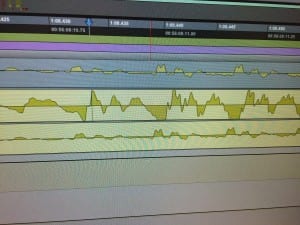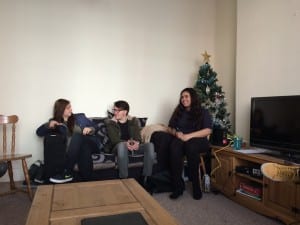(Outcomes – GR2,5 + IN1)
This will be the final situation update for this project, taking place after our final review of the work in progress for all of the films that comprise the artifact. The date of this entry is one week prior to our deadline, so any other pertinent information on the actual carrying out of the project will be included in my final summary.
We have received picture locks for all the films except Immort throughout the early part of April. All of these have, naturally, then been broken by the various editors and directors in charge to a greater or lesser degree after we have started work on the fine audio work, mostly due to a lack of understanding of the import of the word ‘lock’ on the part of student filmmakers.
Descent and Sour Puss are nearing the final mix stage, with foley, dialogue, music and SFX all largely complete. We estimate these films will require another 12 hours of work between them to complete.
Remember has fallen behind schedule due to poor practice on the part of it’s editor complicating our dialogue edit. We estimate another 15 or 20 hours of work will be required here.
Feel Good is still technically incomplete because the production team have failed to factor production of the montage sequences they’d slated throughout into their timeline, but it’s supervisor assures us we will be handing in the version slated to arrive at end of play today or, failing this, the one we have already been working on regardless of further changes to picture. This will require a further 15 hours of working time.
Having seen it’s ambitious plan for the ‘real-life’ aspects of the film largely stymmied, pressure on the visual FX team working on Immort appears to have increased. This has caused an extension to be required to the production, but we are still required to deliver the film with audio complete on the 5th, in time for it’s premiere. In addition, the repeatedly delayed VFX cut of the film is now promised to us on Monday the 2nd May – 4 days prior to our own hand-in date. This is not ideal, but the supervisor of the film is confident it can still be delivered since much of the work on the film (such as scoring, dialogue and foley editing) is complete. We’ve collectively agreed that this is the concrete outer limit of what we consider achievable, and that we will be required to hand in the version without VFX we’ve already largely compelted if this final deadline moves any further. It is difficult to estimate how much time the film will need, since the VFX could make the current audio obsolete, but we’re prepared to commit a further 8 hours if necessary (the film is relatively short). [GR2]
My contribution has largely been made to Descent since it’s pictures began to arrive, with some extra sound design work for Immort based on the concept art for the as-yet-incomplete VFX and basic atmosphere work for Remember also taking up some creative time. Foley editing of Descent has proven quite complex, as the mix of production audio and foley I’ve settled on is difficult to achieve the correct balance of in terms of the environments depicted. The dialogue edit (which was largely handled by another member of the group) also suffered from unpleasant room effects (despite being of good quality), and required a large amount of treating and balancing to complete. [GR5 + IN1]
Time spent on admin has noticably dropped off this month but has essentially been replaced with internal quality control meetings driven by the interminable watching of the different edits as they’ve come in and the transfer of sessions and data around different facilities, and the changes to ostensibly locked pictures have also lost us extra time resyncing audio. Elsewhere, the cancelling of our facilities bookings have also continued to reverberate, with us having to stake-out the Sound Theatre three days of each week and second guess the movements of other students in an effort to find extra time for foley, VO recordings and sync work.
Reflecting on the situation presented here, we’ve been reasonably fortunate that only one film has been significantly delayed in production and even then in a way which has enabled us to work on it regardless, but the final week sees us in a position just shy of the required number of facilities hours we need to complete and mix the films, a situation which could become severely problematic if further issues arise from Immort’s incomplete state.
The process of collaboration and feeding back amongst the group during the post phase in April has been very useful to everybody, not least in my case with Descent – This film has been an exemplary example of the collaborative effort we undertook in post, with dialogue edit, music construction and foley / SFX all benefiting from a significant collective contribution which has then been brought together, finessed and is just about ready for mix. I have learnt however that this process is similarly time consuming and that it effectively takes the place of the administrative work from the earlier part of the process, though I believe it is just as critical for achieving our desired outcomes.
In the sense of effective collaboration the project has undoubtedly been a success, with five films now largely complete to a much better standard than we could have managed as individuals. [GR2]
—————————-
KEY POINTS –
Overview of situation with a week to deadline, and plans moving forward. – Process Management
[GR2] To organise and fulfil an operating strategy and schedule which deals with multiple productions simultaneously, and which maximises efficiency and minimises issues or risks to delivery.
Breakdown of work carried out in April so far – Contribution
[GR5] To produce soundtracks comprising of foley, SFX, dialogue, music and atmospheres to client specifications that synergistically support the other components of their films.
[IN1] To successfully manage the provision of service by the business for the film Descent with regard the assignment of resources, specialisms and working time, liason with the director, editor and producer on a practical and creative level, and communication of information on their needs and requirements for the piece in order to appraise the efficacy of the collaborative approach to working on the piece – (Supervisor and Company Officer)
Reflections on the process – Individual Reflection
[GR2] To organise and fulfil an operating strategy and schedule which deals with multiple productions simultaneously, and which maximises efficiency and minimises issues or risks to delivery.

